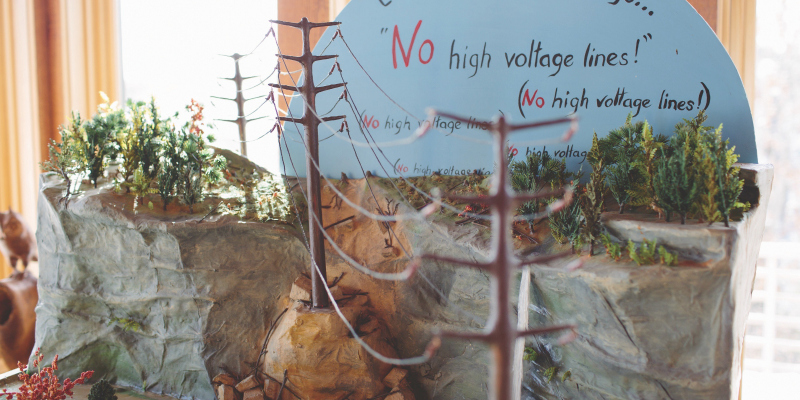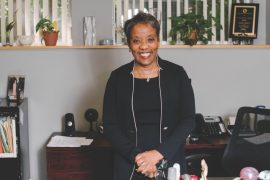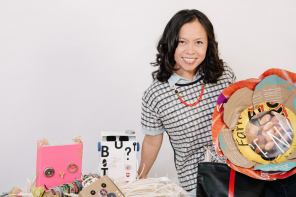By Julia Richards | Photographed By Kaia Calhoun
One of the most rewarding ways to get active is by engaging in one’s community. Opportunities to get involved abound in the Madison area, with thousands of nonprofits in need of volunteers, not to mention all of the neighborhood groups, parent-teacher organizations and communities of faith that would love a helping hand.
Some volunteers don’t consider themselves activists, and some say being involved is just a part of who they are. Many work in small groups that don’t get any press, and they take incremental steps toward the changes they want to make. They may be invisible opera- tives, but they play a key role in shaping the fabric of our society, from the ground up.
While the volunteers profiled here are working on different issues in different arenas, a number of common threads emerge from their stories, all of which, woven together, show that community activism may be hard work, but it is empowering, vitally important and…downright fun.
Just showing up to meetings or sending emails makes a difference
Getting active in the community is frequently unglamorous. Often what’s needed is just showing up at meetings or sending out emails. “Sometimes you just need people to step up and fill positions,” says Heather Hempel Gomez, who has put in a decade of service on the board of Returned Peace Corps Volunteers of Wisconsin-Madison.
The Driftless Defenders, a group opposing the proposed Cardinal-Hickory Creek transmission line, which would extend through the scenic Driftless Region, spend hours sending out emails to coordinate efforts or encourage people to show up and voice their opinions at public meetings.
And much of Beth Esser’s work as cofounder of Madison Gas and Electric Shareholders for Clean Energy is the straightforward, yet vital work of following through. “Making sure you plan the next meeting, making sure you send the follow up email. Those are things that anybody can do, but if you don’t have that, then groups disband and stop existing,” she says.
BETH ESSER: WORKING WITHIN YOUR SPHERES OF INFLUENCE
 When their son was born, Beth Esser and her husband bought stock in local utility company Madison Gas and Electric because their financial planner said it would be a good investment. While the dividends have increased over the years as hoped, Esser is concerned that climate change threatens the very future she is investing in, and a significant portion of MGE’s energy comes from greenhouse gas-emitting coal.
When their son was born, Beth Esser and her husband bought stock in local utility company Madison Gas and Electric because their financial planner said it would be a good investment. While the dividends have increased over the years as hoped, Esser is concerned that climate change threatens the very future she is investing in, and a significant portion of MGE’s energy comes from greenhouse gas-emitting coal.
Many climate activists have pushed for divestment from such fossil fuel-reliant companies, but given MGE’s local presence and its local shareholders, Esser thought shareholder advocacy might be a productive strategy instead. “As shareholders you have a right to engage with the company you own shares with,” she says.
Esser, a stay-at-home-mom at the time, joined forces with fellow shareholder Don Wichert in 2014 and reached out to other shareholders they identified. Together they formed MGE Shareholders for Clean Energy with 100 people on an email list (including the author, for full disclosure) and 15-20 active members. The group’s main mode of engagement with the company is submitting resolutions that can be brought to a vote at the annual meeting. “It’s our leverage point as shareholders to say ‘we have these concerns and we want them addressed by the board,’” Esser says of the resolutions.
Since 2014 the group has formally submitted seven resolutions, all regarding the need for MGE to transition to renewable energy to reduce its climate impact and protect shareholders’ investment. “What we’ve always said is, ‘what’s good for the planet is good for our pocketbook,’” Esser says.
Since many factors influence the direction of a company it’s hard to measure the impact the group has had, but Esser believes one of its resolutions helped push the company to announce in 2017 a goal of 80 percent reduction in emissions by 2050.
While pleased that MGE has taken steps in the right direction, the group continues to exist to push the company to do more. “I know MGE is a small utility in the bigger picture of our national scene, but I think it’s important that we all work around environmental issues, specifically climate change, in our little spheres that we can influence,” Esser says. Co-founder Don Wichert speaks to Esser’s dedication: “She arranges all the meetings, does all the communicating with our shareholder list and has the most passion on climate change issues of anyone in our group.”
ALI MULDROW: CREATING NEW WAYS OF DOING THINGS
 Community involvement and being a catalyst for social change seem to permeate all aspects of Ali Muldrow’s life. She works to create just schools for LGBTQ youth around the state as co-director of GSAFE, serves on two local nonprofit boards, serves on Governor Evers’ criminal justice reform committee, hosts “A Public Affair” weekly on WORT 89.9 FM and is running for a seat on the Madison school board—among other things.
Community involvement and being a catalyst for social change seem to permeate all aspects of Ali Muldrow’s life. She works to create just schools for LGBTQ youth around the state as co-director of GSAFE, serves on two local nonprofit boards, serves on Governor Evers’ criminal justice reform committee, hosts “A Public Affair” weekly on WORT 89.9 FM and is running for a seat on the Madison school board—among other things.
Fundamentally Muldrow sees herself as an educator and communicator. “I am first responsible to give people good information that they can use and apply to their lives,” she says. She’s long been drawn to radio as a way to have interactive conversations. She did her first interview on community radio station WORT at age 17 as part of a class.
Muldrow shows a curiosity, earnestness and calm confidence that lend themselves to hosting radio. Having meaningful conversations is clearly important to her. “To have these moments of vulnerability, and frankness, and honesty about our experiences challenges the way we interact with people,” Muldrow says.
She strives to use the show to “emphasize that another way of doing things, another way of seeing each other, another way of communicating is possible.”
In her bid for school board Muldrow is running a joint campaign with another female candidate of color, Ananda Mirilli. The two are collaborating on fundraisers and events. Running parallel campaigns means, “to support another person’s leadership, to think working with that person would be a profound opportunity,” Muldrow says.
The consent culture she teaches professionally helps Muldrow be able to balance her many activities by keeping strong boundaries. Her advice to those looking to get involved in the community is to “do things that you love to do and do things that make you happy and allow you to be connected to people you care about.”
Participating in local democracy is empowering
Since our governments are supposed to serve our communities, it makes sense that getting involved in the community can be a lesson in the inner workings of local government. “Understanding a little better the systems that are shaping our daily lives,” is something Diane Farsetta appreciates from her role representing the Emerson East neighborhood on a regional city planning council. She also attended city meetings to speak in favor of locating the Occupy Madison Tiny Village in the neighborhood and helped address neighbors’ concerns about the project.
After making some changes to the original plans, the groundbreaking village was built and has integrated successfully into the neighborhood. “This is an example of how local democracy works and I think it’s a really good one,” Farsetta says.
The Driftless Defenders have also gone to many public meetings, mainly at the county level, where they spoke in favor of resolutions opposing American Transmission Company’s proposed high voltage lines. Lianne Stephenson tells how 100 people showed up to one meeting, “including my 12-year-old daughter who came with me and got to see the government at work.”
Deb Eide, also a member of the Driftless Defenders, says it takes courage to speak at a public meeting. “None of us want to do the public speaking, but we all have, because we don’t want to let each other down,” she says.
DEB EIDE, BETSY D’ANGELO & LIANNE STEPHENSON: UNINTENTIONAL ACTIVISTS FOR THE LAND THEY LOVE
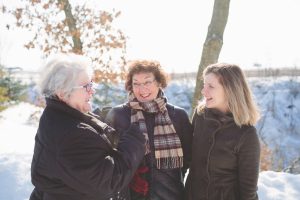 “None of us ever had a bumper sticker on our car, never had a yard sign in our front yard,” says Lianne Stephenson. She is sitting at a large wooden dining room table, set with tea and scones along with friends Deb Eide and Betsy D’Angelo. None of the women considered themselves to be activists before getting involved with Driftless Defenders, a group organized in opposition to the Cardinal-Hickory Creek transmission line proposed by American Transmission Company (ATC) to span three counties in southwest Wisconsin.
“None of us ever had a bumper sticker on our car, never had a yard sign in our front yard,” says Lianne Stephenson. She is sitting at a large wooden dining room table, set with tea and scones along with friends Deb Eide and Betsy D’Angelo. None of the women considered themselves to be activists before getting involved with Driftless Defenders, a group organized in opposition to the Cardinal-Hickory Creek transmission line proposed by American Transmission Company (ATC) to span three counties in southwest Wisconsin.
Now they’ve seen the same bumper stickers their own vehicles sport all over parking lots at county board meetings, on vehicles otherwise populated with both left- and right-leaning stickers.
The women laugh frequently as they tell about their efforts since 2016 to prevent the transmission line from bisecting the landscape they so clearly love. We are sitting in D’Angelo’s house located just north of Governor Dodge State Park at the edge of a steep, wooded ravine. She draws my attention to an icefall spilling from a rocky ledge.
Pointing out the large windows to the ridge on the opposite side of the ravine, D’Angelo, a retired teacher, says that’s where the 17-story-tall towers would run if ATC built along this route.
It’s hard to imagine such an industrial aesthetic in this pastoral landscape, but the women emphasize they are not opposing the line primarily because of their personal property. “We’re not NIMBY people,” says Eide, a retired art teacher. “Our opposition is that we don’t need it.” The group argues that electricity demand has been flat or falling in Wisconsin and grid reliability is already good, so such a line holds no benefit for local residents.
“As citizens we think that the utilities would be making good decisions and we think that the government—at least I thought—that the government would not even consider building something like this that’s not needed,” says Stephenson, a physician at UW Hospital.
When the group first organized, “Driftless Defender’s main mission was to raise public awareness,” explains D’Angelo. That meant making brochures, a website, those bumper stickers and yard signs, and becoming a presence in the summer staple of small-town parades. This was all new to them, and D’Angelo says, “I really felt like a fool to be honest,” but they gradually became more comfortable finding their voice in speaking up for the unique landscape they call home.
Eide felt it was important to give people a visual representation and created a scaled diorama showing the transmission towers with a farmstead. It’s been displayed at public meetings and area public libraries.
The Driftless Defenders have formed a coalition with other area groups against the line which is currently in the review process before the Public Service Commission. Two counties, Iowa and Dane, are now intervenors in the case, opposing ATC.
Whatever happens next, Stephenson, D’Angelo and Eide agree, they are not giving up. “Someone said, ‘you’re not going to win you know’ and I thought maybe we’re not, but I have to try. We can’t sit by. We have to be one of the ones that does something,” Eide says.
HEATHER HEMPEL GOMEZ: KEEPING VITAL WORK GOING
 It was not long after Heather Hempel Gomez returned in 2001 from a Peace Corps stint in Bulgaria that she connected with the Returned Peace Corps Volunteers of Wisconsin-Madison. Since then she has served in various roles in the organization including membership coordinator, vice-president and president. Still, she is humble about her function in the nonprofit. “I’m not much of a leader, I’m kind of like a worker bee,” she says. When it comes to helping with annual events Hempel Gomez asks, “where do you need me to be, when?”
It was not long after Heather Hempel Gomez returned in 2001 from a Peace Corps stint in Bulgaria that she connected with the Returned Peace Corps Volunteers of Wisconsin-Madison. Since then she has served in various roles in the organization including membership coordinator, vice-president and president. Still, she is humble about her function in the nonprofit. “I’m not much of a leader, I’m kind of like a worker bee,” she says. When it comes to helping with annual events Hempel Gomez asks, “where do you need me to be, when?”
It’s that kind of dedication that keeps the work going of educating people about the Peace Corps, reaching out to welcome local refugee families and raising $25,000 a year for development projects around the world.
“I just stick to my way to contribute to the group because I so much support the group as a whole. And I am able to put the time in to attend the meetings and things like that, because I don’t have children, for example. You know, sometimes it’s just more logistics,” Hempel Gomez says.
Fellow board member Tamara England sees great value in the “real world business experience” Hempel Gomez, a provider support specialist at Exact Sciences, brings to the group. “She…is deft at getting to the heart of a matter under consideration and sometimes defusing conflict. She asks good questions and keeps her eye on the most important efforts of our group,” England says.
While some may find board meetings boring, Hempel Gomez says they’re a way to connect with like-minded people to do meaningful work. “Every time I leave I just feel so good because it’s like, oh wow, we just gave away more money, we just heard more impactful stories from people who are involved in this project or that project,” she says.
Activism is hard work, but not as hard as doing nothing
Community activists can get burned out and may put in a lot of time and energy without seeing much in the way of desired results. But, they say, standing by and doing nothing isn’t a better option.
“For me it would have been more stressful to do nothing, to just let it happen,” says Betsy D’Angelo, who has spent untold hours on the leadership and outreach teams of the Driftless Defenders.
Muldrow expresses a similar sentiment: “There’s a lot of people who look at the work I do and go ‘that would be really hard.’ And I think what would be really hard would be to sit back and live in a world that is unjust. And not doing anything about it. That would be hard. The fun part about living in an oppressive society is fighting to change it, and I love Madison because it’s a great place to believe in change.”
Change takes time
Creating change—whether social change or change in public opinion or reaching a particular goal—takes time. Sometimes a lot of time. All of the community change agents interviewed here though, are willing to take the long view. “When you’re talking about racism or sexism in our society, what you are talking about are value systems that are entrenched over centuries,” says Ali Muldrow, Wednesday host of “A Public Affair” on WORT 89.9FM. “One of the jokes I like to tell people is, this has been going on for centuries, and so we’ve got about eight weeks to fix it.”
Patience and persistence are just part of the process in shareholder activism, according to Esser, whose MGE Shareholders for Clean Energy have been introducing resolutions since 2014 to push MGE to transition more rapidly to renewable energy. Their resolutions, while not immediately accepted by the company, received triple the support needed to be resubmitted the next year. It’s a glacial process, but often necessary to build momentum and see the company make real change.
Remember to celebrate
There’s a definite social aspect to getting involved in the community. Besides the important work of raising and allocating thousands of dollars a year to worthy development projects in communities around the world, the Returned Peace Corps Volunteers have regular happy hours and a hiking group to socialize, Hempel Gomez says.
The MGE shareholders group also socialize at a potluck they have after MGE’s annual meeting where the resolutions get a vote. “Even if it feels sometimes like nothing’s changing or it’s not changing fast enough, you’ve got to take time to celebrate,” Esser says.
This past summer D’Angelo, Stephenson and Eide organized a rally to “celebrate both the Driftless itself, but also all of the people who had been working so hard to protect it,” Stephenson says. They had a live band, pizza and cider from local purveyors and a bike ride on the Military Ridge State Trail.
As feminist activist Emma Goldman once said, “If I can’t dance, I don’t want to be part of your revolution.”
DIANE FARSETTA: EXPANDING OUR SENSE OF COMMUNITY
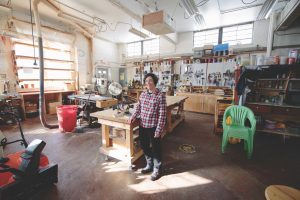 Diane Farsetta says being engaged in the community is part of who she is. After starting grad school at UW-Madison, the first thing she got involved with was the East Timor Solidarity movement at the university. The group helped set up a sister-city relationship with Ainaro, East Timor. Former Alder Barbara Vedder was the lead sponsor on that resolution and saw Farsetta’s leadership potential.
Diane Farsetta says being engaged in the community is part of who she is. After starting grad school at UW-Madison, the first thing she got involved with was the East Timor Solidarity movement at the university. The group helped set up a sister-city relationship with Ainaro, East Timor. Former Alder Barbara Vedder was the lead sponsor on that resolution and saw Farsetta’s leadership potential.
When Farsetta attended her first meeting of the Emerson East Neighborhood Association Vedder nominated her to represent the neighborhood on the East Isthmus Neighborhood Planning Council. Since then, Farsetta has helped with various neighborhood efforts including establishing a community garden and planning public art projects.
“She’s been deeply committed to our neighborhood association and tremendously cares about our collective wellness from the individual level to the furthermost part of the international world,” Vedder says.
Farsetta was especially involved when Occupy Madison sought to locate their tiny village of houses for homeless residents in the neighborhood. “I would speak up and say ‘My house is two blocks from where they’re looking to go in, and I can’t wait for this to happen,’” Farsetta says. She served as a liaison between Occupy Madison and the neighborhood association, helping to address concerns.
Farsetta is proud of the village’s successful assimilation into the neighborhood. “For me it was a really inspiring example in a group that I continue to volunteer with about how we can come together in small ways to make big differences,” she says.
Now Farsetta is running to represent her district on the city council. She sees this as a critical time for the district with the planned public market and the Oscar Meyer redevelopment. “For me the underlying thing is how do we build community and how do we expand what community means?” Farsetta says. “Because Madison is a wonderful place to live for a lot of people, but not for everybody, right? And we need to keep on challenging ourselves to make that definition of community broader.”
For more information visit: mgeshareholders.com; WORTfm.org; driftlessdefenders.com; rpcvmadison.org; occupymadisoninc.com.

